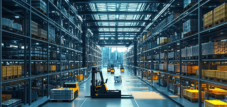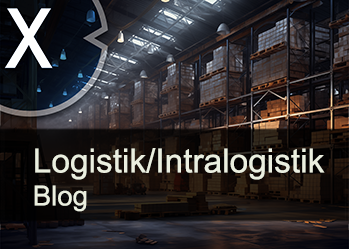The global logistics transformation with container high-bay warehouses: Market development and market demand in regional comparison
Xpert pre-release
Language selection 📢
Published on: November 25, 2025 / Updated on: November 25, 2025 – Author: Konrad Wolfenstein

Global logistics transformation with container high-bay warehouses: Market development and market demand in regional comparison – Image: Xpert.Digital
70% space savings: This technology is revolutionizing global logistics
USA vs. China vs. Europe: The global race for container logistics transformation
While around 90 percent of global freight traffic continues to be handled via the world's oceans, traditional container terminals in major port cities are reaching their physical and operational limits. The era of endless land expansion is drawing to a close; the future of port logistics lies vertically. Innovative high-bay container warehouses, stacking steel boxes up to 60 meters high, promise not only a threefold increase in capacity on the same footprint but also a reduction in land use of up to 70 percent. However, this technological evolution is far more than just a construction project – it reflects the different economic and strategic cultures in various regions of the world.
The market for these automated systems is booming and is projected to reach a volume of over 20 billion US dollars by 2034. However, the motives for this transformation could hardly be more different. While the USA pragmatically views automation as a necessary measure against an acute and structural labor shortage, Europe – especially Germany – relies on engineering precision and long-term partnerships to address the chronic scarcity of available land. Asia presents a completely different picture: China is driving port automation forward with state-sponsored force and strategic five-year plans to secure its technological global dominance, while South Korea is establishing itself as a high-tech innovation hub.
The following report analyzes market development and demand in a regional comparison. It highlights how technologies such as the innovative high-bay warehouse system of a German-Arab joint venture are achieving industrial application, why a “productivity paradox” makes investors hesitant despite obvious advantages, and why the decision for or against high-bay warehouses has long since ceased to be a purely logistical one, but has become a geopolitical one.
When steel giants grow into the sky, the global economy is renegotiated on the ground.
Container logistics is at a turning point that could redefine the entire global supply chain. While traditional container terminals are reaching their spatial limits and around 90 percent of global freight traffic is handled by sea, a technology is emerging as a potential solution: the container high-bay warehouse. These vertical storage systems, which can stack containers up to 60 meters high, promise a threefold increase in capacity on the same footprint and could reduce terminal space requirements by up to 70 percent.
The global market for automated storage and retrieval systems was valued at approximately US$9.9 to US$10.6 billion in 2024 and is projected to grow to around US$21 billion by 2034, representing a compound annual growth rate of about eight percent. The specific market for high-bay storage systems was valued at US$13.2 billion in 2024 and is expected to reach US$28.7 billion by 2033, with annual growth of 8.9 percent. The more general high-bay storage market, including all components, was valued at US$18.2 billion in 2024 and is projected to reach US$36.7 billion by 2033.
The technology has found a market-ready solution in a system developed through a joint venture between a global port operator and a leading German plant engineering company. Following a two-year pilot phase with over 200,000 container movements at Terminal 4 in Dubai, the first commercial deployment began in 2023 at the Pusan Newport Corporation Terminal in South Korea, which already handles 5.3 million TEU annually. This development marks the transition from innovation to industrial application and opens up new perspectives for global port logistics.
The American perception: Pragmatism meets labor crisis
Race against the skills shortage as a key investment driver
The United States is approaching warehouse automation with a characteristically pragmatic attitude, where return on investment is the central decision-making criterion. The North American market for automated warehouse systems was valued at approximately $3.44 billion in 2024 and is projected to grow to $7.09 billion by 2034, representing a compound annual growth rate (CAGR) of 7.5 percent. The broader North American warehouse automation market was valued at $9.6 billion in 2024 and is expected to reach $26.4 billion by 2032.
The most significant driver of this development is the acute labor shortage in the logistics industry. According to industry experts, the biggest challenge in North America is the lack of available workers, with even those who are available often unable to be retained long-term and frequently moving between different warehouses. This situation has transformed automation from a strategic option into an operational necessity. Research by the U.S. Department of Energy shows that warehouses with automation solutions experience, on average, 30 percent lower operating costs and 40 percent faster order fulfillment. The National Institute of Standards and Technology also reports that automated warehouses have 65 percent fewer picking errors than traditional facilities.
Trade policy uncertainty as a structural challenge
The American logistics landscape is currently being significantly impacted by trade policy turmoil. As Drewry analyst Simon Heaney put it, the maritime consulting firm has never experienced such disruption in its 46-year history, with the outlook now more uncertain than at the start of the COVID-19 crisis. The fluctuating tariff policies make proper business planning impossible, and the only certainty is that global container tariffs are falling and trade with the United States is declining.
This uncertainty has led to a surge in demand for bonded warehouses, where goods can be stored for up to five years without incurring customs duties. Such facilities, which date back to the 19th century, allow importers to quickly take advantage of sudden tariff reductions without their goods being stuck on container ships. Container rates between China and the US West Coast have fallen from $5,606 to $2,089 per 40-foot container in just four weeks.
Technological perception and adoption barriers
Despite the clear economic benefits, over 80 percent of warehouses in the US have not yet implemented automation, representing enormous untapped potential. However, Gartner forecasts that by 2028, 80 percent of warehouses and distribution centers will be using some form of automation. The main barriers are high installation costs for small and medium-sized businesses and the complexity of integrating with existing warehouse management systems. Added to this are resistance to changing traditional manual processes and concerns about system reliability and maintenance.
American perceptions of technology are heavily influenced by the dominance of major e-commerce players. Amazon and Walmart are leading the automation wave, and their investments are setting the standard for the entire industry. The US market favors highly automated systems with strong integration into warehouse management systems, with twin-mast stacker cranes being particularly sought after for high-bay warehouses up to 45 meters high due to their higher load-bearing capacity and stability.
The European and German perspective: Precision engineering and long-term partnerships
Engineering culture as a competitive advantage
Europe holds the largest market share of the global ASRS market at 36.27 percent. This position is based on a fundamentally different approach to warehouse automation than in the USA. The European, and especially the German, perception is characterized by a long-term partnership mentality, with German suppliers emphasizing lifetime partnership concepts and 24/7 support. The focus is on space efficiency, energy savings, and precision-engineered systems, with stacker cranes reaching heights of over 40 meters using patented load handling devices such as Westfalia's satellite system for multi-deep storage.
Demand for extra-large warehouses exceeding 40,000 square meters remains strong in Europe, accounting for 25 percent of total activity in 2023 with 16 completed projects. The trend toward multi-story, state-of-the-art warehouses is gaining momentum in both the US and Europe, with industry experts predicting that logistics will be the most disrupted sector, undergoing a high degree of automation. Multi-story, ultra-modern, ultra-connected warehouses are becoming the norm, with capacities increasing tenfold.
Investment landscape and flagship projects
Investment activity in Europe is remarkable. Hamburger Hafen und Logistik AG (HHLA) has invested over one billion euros in European port logistics in the last five years. The Altenwerder Container Terminal in Hamburg, developed as a greenfield project in 2002, sets global standards for automated container handling with its high degree of automation and continuously integrates new technologies. HHLA operates 22 electrified storage blocks, which make a significant contribution to the terminal's sustainable development and offer a storage capacity of 45,000 TEU.
In Germany, the Würth Industrie Service project stands out, setting new standards with its impressive height of 100 meters and a capacity of 235,000 pallet spaces. The construction of this imposing high-bay warehouse required millimeter-precise work and a high level of technical expertise, with the stacker cranes, measuring 46 meters in length and weighing 22.5 tons, representing true technological behemoths. The investment costs for a medium-sized, fully automated high-bay warehouse typically range between 5 and 20 million euros.
Strategic priorities and regulatory environment
The European strategy is strongly influenced by resilience considerations. The Draghi Report of 2024 opened the door to a new EU industrial strategy to strengthen the ability of European companies to remain at the forefront of innovation while building efficient, resilient, and sustainable value chains. The EU is intensively strengthening its supply chain resilience through diversification, digitalization, and sustainability, with organizations that adopt these strategies early being better equipped to weather ongoing disruptions and seize new opportunities.
A particular problem is the projected supply gap. By 2030, the supply gap for sustainable logistics space in Germany is expected to reach 42 percent, while across Europe, demand will exceed supply. This scarcity of space is further driving the demand for vertical storage solutions and making high-bay warehouses an economically essential necessity.
LTW Solutions
LTW offers its customers not individual components, but integrated complete solutions. Consulting, planning, mechanical and electrotechnical components, control and automation technology, as well as software and service – everything is networked and precisely coordinated.
In-house production of key components is particularly advantageous. This allows for optimal control of quality, supply chains, and interfaces.
LTW stands for reliability, transparency, and collaborative partnership. Loyalty and honesty are firmly anchored in the company's philosophy – a handshake still means something here.
Suitable for:
From just-in-time to just-in-case: The new era of goods flows towards automated mega-warehouses
Asia without China: Dynamic markets with different development paths
Regional diversity and strategic positioning
The Asia-Pacific market for automated warehouse systems was valued at US$6.4 billion in 2023 and is projected to reach US$11 billion by 2031, with a compound annual growth rate (CAGR) of 7.4 percent. The region is experiencing increased demand for automation technologies, with government reports indicating that approximately 81 percent of surveyed companies in the region are likely to deploy industrial robots to optimize their processes.
Asian ports dominate the global Container Port Performance Index, with 18 of the world's 25 leading ports located in Asia, including 11 in East Asia and four in West Asia. The Port of Yangshan in China ranks first, having risen from fourth place in 2021. Yangshan has invested in transshipment operations, developed automation, and improved the interoperability of its systems between border authorities and logistics operators.
South Korea as an innovation center
South Korea is positioning itself as a major transshipment hub in Asia, with a strategic focus on smart port infrastructure. Large ports like Busan are relying on AI-based predictive analytics, automated cranes, and data-driven logistics. The automated container terminal market in South Korea is projected to grow by 7.9 percent annually until 2035.
The first commercial deployment of the aforementioned high-bay racking technology at the Pusan Newport Corporation Terminal represents a significant milestone. The system is being seamlessly integrated with the existing automated rail-mounted gantry cranes and truck operations as a retrofit on an existing, unused warehouse area. It is expected to eliminate 350,000 unproductive movements per year and improve overall truck handling time by 20 percent.
Japan, Singapore and India
Japan has seen growth in the e-commerce sector as a major driver of ASRS adoption, with online retail growing at an annual rate of 7.3 percent between 2017 and 2022. This shift to online shopping has prompted logistics companies to invest in advanced technologies like ASRS to manage inventory more effectively and reduce delivery times.
Singapore has invested heavily in infrastructure and was ranked a top global logistics hub by the World Bank in 2023. The city-state's logistics centers boast state-of-the-art warehouses, automated container terminals, and integrated transport networks. Automated container terminals utilize AI and robotics for efficient cargo management, reducing turnaround times and minimizing errors.
India leads the cold chain logistics sector with a projected annual growth rate of 5.30 percent, demonstrating the highest growth potential in the region, supported by infrastructure financing and digital logistics platforms. The Indian government is currently developing one of the deepest transshipment ports on Great Nicobar Island with total investments of US$4.9 billion.
The Chinese strategy: State-led infrastructure revolution
National priorities and five-year plans
China is pursuing a fundamentally different approach than Western markets. The Chinese market for automated container handling systems was estimated at 15.37 billion yuan in 2025 and is projected to grow at an annual rate of 7.24 percent. China is the undisputed leader in port automation and, by the end of 2024, already operated 52 automated terminals, more than any other nation worldwide.
The Chinese government's strategic emphasis on port modernization and infrastructure development is a primary growth driver, encouraging large investments in automation. The Made in China 2025 initiative, partly inspired by Germany and Industry 4.0, aims to boost the country's manufacturing competitiveness. Simultaneously, the Belt and Road Initiative is driving infrastructure spending, with China's ports at the forefront of automation.
Benchmark investments and technological integration
In 2024, Chinese ports handled a remarkable 17.6 billion tons of cargo and 330 million TEU containers, solidifying China's position at the top of global port rankings in both total cargo throughput and container throughput. The Port of Shanghai handled 51.51 million TEU in 2024, maintaining its position as the world's leading container port for 15 consecutive years.
The ongoing development in the northern part of Xiaoyangshan Island aims to add a new 6,100-meter coastline, including a 5,500-meter container terminal coastline with seven 70,000-ton and 15 20,000-ton container berths, with a planned annual throughput capacity of 11.6 million TEU. Investments in the project already exceed 6 billion yuan, with further projected investments of over 4 billion yuan.
5G as the foundation of the logistics future
China has elevated 5G integration and application to a strategic planning level to accelerate the construction of new infrastructure and the innovation of 5G application scenarios. 5G smart logistics has been identified as one of the measures to deepen 5G integration and application across industries. The plan proposes strengthening innovation in the application of 5G in logistics in parks, warehouses, communities, and other locations.
JD Logistics has launched a 5G-automated warehouse with over 100 5G-connected autonomous vehicles and reports a 200 percent increase in efficiency. The system combines IoT devices, edge computing, cloud computing, a 5G network, and proprietary systems to enable automated management and operation of the logistics process. Robots connected to cloud computing can effectively reduce local computing costs by more than 80 percent.
Investments at the smart terminal in Tianjin amounted to 5.2 billion yuan. This investment in smart container terminals is on par with that for traditional terminals, but smart ports offer higher efficiency: the operating efficiency of a single gantry crane increases by more than 40 percent, while labor costs decrease by 60 percent.
Economic realities: The gap between promises and practice
The productivity paradox of automated ports
Despite the obvious advantages, empirical evidence paints a more nuanced picture. According to a study by the International Transport Forum, there are only 53 container terminals worldwide that are automated to any degree, representing approximately four percent of global container terminal capacity. Fully automated container terminals do not yet exist; most automated systems are deployed in container storage, and only a few terminals have automated transport between the quay and the storage area.
A McKinsey analysis found that automated ports are actually seven to 15 percent less productive than conventional terminals in certain samples. The return on invested capital for some automated ports is up to one percentage point below the industry standard of around eight percent. The average number of gross movements per hour for quay cranes is in the low twenties for fully automated terminals, while it is in the high thirties for many conventional terminals.
Conditions for successful automation
To justify the high upfront investments, the operating costs of an automated greenfield terminal would need to be 25 percent lower than those of a conventional terminal, or productivity would need to increase by 30 percent while operating costs decrease by 10 percent. However, actual operating cost reductions are only between 15 and 35 percent. With careful planning and management, however, operating costs could be reduced by 25 to 55 percent and productivity could increase by 10 to 35 percent.
Container terminals with a relatively stable market and guaranteed throughput are better suited to high levels of automation due to their regular cargo flows. In contrast, terminals with fluctuating throughput are better served with less automation, as this preserves greater flexibility. Gateway terminals generally have a certain level of captive container volume and therefore tend to be better suited to automation than transshipment terminals with more volatile container volumes.
The time horizon of profitability
A study by 4flow Consulting shows that demand volatility increases the payback period for warehouse automation and reduces service levels. The high fixed costs of the technology can complicate the decision of whether to automate. Ultimately, the business case for automation depends on well-informed planning and accurate forecasts of future demand.
For the entire port ecosystem, including terminal operators, shipping companies, intermodal operators, freight forwarders, shippers, and consignees, the value of Port 4.0 could exceed US$1.5 billion per year for a port handling both imports and exports. However, terminal operators would directly capture less than 20 percent of this value pool, while other parties in the ecosystem would claim the remainder.
Comparison of regional perceptions and strategies
The fundamental differences in regional perceptions of the container high-bay warehouse market reflect deeper cultural, economic, and political divergences. In the US, a reactive, ROI-focused approach dominates, where automation is primarily seen as a response to the acute labor shortage. Investment decisions are heavily driven by payback periods, with autonomous solutions like AMRs promising a payback time of approximately 24 months.
In Europe and Germany, the perception is characterized by long-term partnerships, precision engineering, and integration into broader industrial strategies. The German Industry 4.0 movement has conceived of automation as a technology-driven transformation that integrates physical and digital technologies, leading to networked systems that not only communicate but also analyze data to make informed decisions.
China pursues a state-directed approach with massive infrastructure investments embedded in five-year plans. Port development is treated as a national strategic priority, with the integration of 5G, AI, IoT, and blockchain representing a comprehensive technological ecosystem approach. The replication and scaling of successful models through the Belt and Road Initiative demonstrates the export-oriented nature of China's strategy.
While the US relies on tactical adaptation to market conditions, Europe plans strategically and for the long term, and China implements quickly and in a government-driven manner. These differing speeds and philosophies will shape the global competitive landscape in the coming decades, with 80 percent of industry experts expecting that at least half of all greenfield port projects will be semi- or fully automated within the next five years.
Containerized high-bay warehouse technology is on the verge of a breakthrough, with the transition from innovation to industrial application having begun with its first commercial deployment in Busan. However, regional differences in market perception and investment strategies will mean that this breakthrough will occur at different speeds and in different forms in different parts of the world, which could ultimately and permanently alter the structure of global supply chains.

Xpert.Plus warehouse optimization - high-bay warehouses such as pallet warehouses consulting and planning
We are there for you - advice - planning - implementation - project management
☑️ Our business language is English or German
☑️ NEW: Correspondence in your national language!
I would be happy to serve you and my team as a personal advisor.
You can contact me by filling out the contact form or simply call me on +49 89 89 674 804 (Munich) . My email address is: wolfenstein ∂ xpert.digital
I'm looking forward to our joint project.
























